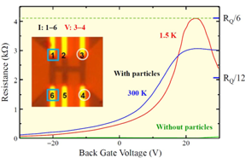Turning a Graphene into a Topological Insulator with Surface Decoration
J. Haruyama, S. Katsumoto, and T. Nakamura
Graphene once played a key role in the development of topological insulators, which exhibit an electrically inert interior yet form metallic states at their boundary (the edge states). Kane and Mele, in 2005, predicted that coupling between the spin and orbital motion of electrons turns graphene (or some honeycomb lattice) into a ‘quantum-spin-Hall (QSH)’ insulator that hosts spin-filtered metallic edge states with inherent resilience from scattering. These novel edge states underlie tantalizing technological applications for low-power electronics, spintronic devices, and fault-tolerant quantum computing. Although graphene’s intrinsic spin-orbit coupling is far too weak to produce an observable QSH phase in practice, numerous alternative platforms were subsequently discovered, including HgTe and InAs/GaSb quantum wells, WTe2, bismuthene, and the layered compound Bi14Rh3I9.

Fig. 1. Inset: AFM image of the sample. The vague dark regions are fabricated graphene with fine particles. The yellow-colored regions are Au electrodes. The blue squares indicate the current electrodes and the white circles the voltage electrodes. At 1.5 K, with varing the back gate voltage, the resistance increases and hits 1/6 of the quanutm resistance, which is just expected for the configuration of the electrodes and perfect conductance connection between them.
Realization of the QSH effect in graphene devices has remained an outstanding challenge dating back to the inception of the field of topological insulators. Graphene’s exceptionally weak spin-orbit coupling—stemming from carbon’s low mass—poses the primary obstacle. We experimentally study artificially enhanced spin-orbit coupling in graphene via random decoration with dilute Bi2Te3 nanoparticles. Remarkably, multi-terminal resistance measurements suggest the presence of helical edge states characteristic of a QSH phase; those magnetic-field and temperature dependence, X-ray photoelectron spectra, scanning tunneling spectroscopy, and first-principles calculations further support this scenario. These observations highlight a pathway to spintronics and quantum-information applications in graphene-based QSH platforms.
References
- [1] K. Hatsuda, H. Mine, T. Nakamura, J. Li, R. Wu, S. Katsumoto, and J. Haruyama, Sci. Adv. 4, eaau6915 (2018).
